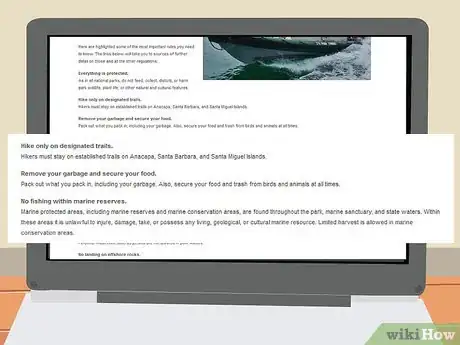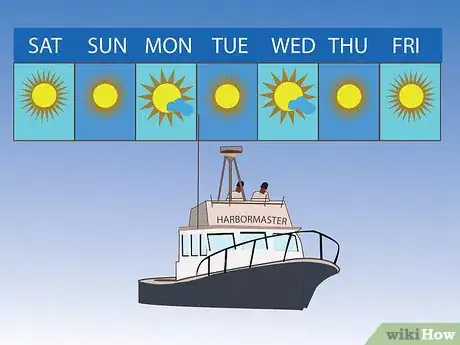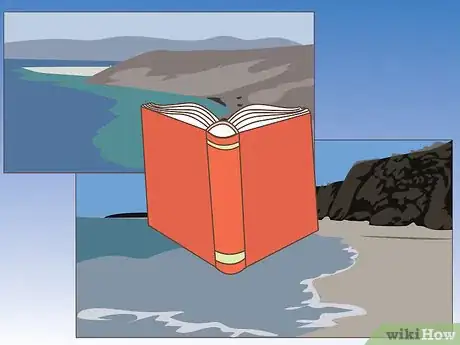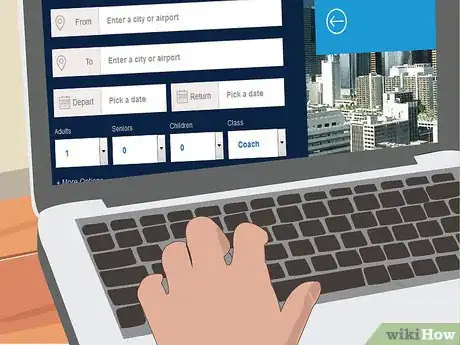wikiHow is a “wiki,” similar to Wikipedia, which means that many of our articles are co-written by multiple authors. To create this article, volunteer authors worked to edit and improve it over time.
This article has been viewed 80,538 times.
Learn more...
Located off the southern coast of California, Channel Islands National Park contains one of the most diverse collection of plant and animal species in the United States. The park is made up of five islands—Anacapa, Santa Cruz, Santa Rosa, San Miguel and Santa Barbara—with each one providing visitors with a wide variety of spectacles to see and things to do. Best of all, the park is close enough to several California cities that getting there is a quick and easy trip.
Steps
Doing Your Research
-
1Read up on all of the fees involved in a visit to the Channel Islands. The park’s website lists all of the expenses you’ll incur during your trip:
- General admission to the park is free.
- Those wishing to camp on one of the islands will be charged a fee of $15 per campsite per night. The money is used to help preserve the park. Reservations must be made ahead of time, and can be arranged via the National Recreation Reservation Service website. Reservations can be made no more than 5 months in advance.
- Visitors who choose to access the islands by boat will be charged between $50 and 75 round trip per person. Children aged 2 and under travel free. Those bringing surfboards along will be charged extra. Reservations can be made either by contacting the park’s visitor center or through the Island Packers Cruises website.
- Visitors who elect to access the islands by plane can do so via Channel Islands Aviation. Costs vary depending on which experience you choose. Day trip flights cost roughly $150 to 160 per adult round trip, and $125 to 135 per child. Exclusive camping trip charters are also available during the summer months at a cost of $300 per person (minimum 4 campers), $1,600 for a seven-passenger charter from Camarillo, and $2,000 for a seven-passenger charter from Santa Barbara.
-
2Learn the rules of the park. As with most national parks, Channel Islands has restrictions on where visitors can go, and what they can do. For example, Channel Islands emphasizes limiting visitors’ footprints during their stay. Visitors are asked to avoid areas where animals are nesting, limit the use of artificial light at night, and stay out of caves altogether. The park website contains a detailed list of restrictions and allowances; studying these is an absolute must for anyone planning to make a visit.
Accessing the Channel Islands By Public Boat
-
1Make your reservation.
- After clicking the “View Schedule & Availability” button near the top of the home page, you’ll be taken to a page with a list of the Channel Islands. Choose the island you wish to visit, pick a day and time and select how many people are making the trip.
- The next page will list return dates. Choose when you would like to make your way back to the mainland, and the site will calculate your balance. If you don’t have an account with the site, you will need to make one here before proceeding to the payment screen.
- Space on each cruise is limited, and some islands are inaccessible on certain days or times. Additionally, trips made during peak times in the afternoon are subject to higher fees than those scheduled for earlier or later in the day.
-
2Read the travel policies carefully. Among the things you’ll need to know:
- Travelers must arrive one hour before departure time, and all gear must be on the boat no later than 30 minutes prior to departure.
- No single item can exceed 45 pounds (20 kg). There are no exceptions to this rule.
- All gear should be marked with name, phone number, and color-coded tag corresponding to your arrival island.
-
3Make your way to the dock located at the visitor center and board the boat when called upon. Parking at the visitor center is limited, so carpooling is recommended if you are traveling in a larger group.
Accessing the Channel Islands by Private Boat
-
1Determine your course and destination island. A number of factors should be considered before choosing deciding when and where you plan to go:
- Weather: Conditions in the channel vary dramatically, with shifting swells, high waves, and fog making the trip an even greater challenge. Anyone planning to make the voyage should consult the NOAA Weather Service (phone), the Channel Islands Internet Weather Kiosk (online), or weather radio via VHF-FM 162.475 MHz (marine forecast), VHF-FM 162.55 MHz, or VHF-FM 162.40 MHz (land-based observations).
- Shipping Lanes: The trip across the channel will take boaters through some of the busiest shipping lanes on the California coast. Those making the trek should be aware of where the shipping lanes are and use extreme caution when crossing them. Additionally, the waters in and around the islands are occasionally shut down for military exercises.
- General information: Before making the trip, all boaters should seek out the U.S. Coast Guard’s “Local Notice to Mariners,” which can be obtained by contacting the USCG directly. Nautical charts can be purchased at nearby marine stores, at bookstores, or online.
-
2Study your destination island’s landing procedures. It is suggested that boaters consult each island’s respective park ranger before landing. Boaters can use a VHF channel to hail the rangers, who will then ask the boater to switch to a different channel for the purpose of providing a brief orientation, landing instructions, and other details. Here is a brief look at landing protocol for the five major islands:
- Santa Barbara Island: No permit is required. Boaters must access the island through the landing cove, as dock access is limited to unloading vessels.
- Anacapa Island: No permit is required for boats landing at East Anacapa or Frenchy’s Cove. A permit is required for boats landing at Middle Anacapa and a park ranger must accompany any visitors. Access to West Anacapa is prohibited. Boaters may not use moorings located at East Anacapa; these are reserved for other boats. Visitors must tie their boats a reasonable distance from these moorings. Permits can be obtained via The Nature Conservatory website.
- Santa Cruz Island: The eastern quarter of the island is accessible without a permit. Buoy access is prohibited, though boaters are permitted to use the pier at Scorpion Anchorage or Prisoners Harbor. Surf conditions here are particularly treacherous, so boaters are encouraged to use caution. A permit is required to access the remaining three-quarters of the island. Permits can be obtained via The Nature Conservatory website.
- Santa Rosa Island: Boaters can use the coastline or beaches to land without a permit, though access is limited to a maximum of one day. Piers are available at Beaches Bay, but visitors may not use area buoys.
- San Miguel Island: Boaters may land at Cuyler Harbor or Tyler Bight for overnight stays. Visitors may only land on the beach at Cuyler Harbor.
-
3File a formal float plan with the harbormaster prior to leaving. The float plan should be as detailed and specific as possible. Be sure to include personal information for every person in the boat, as well as destination specifics (departure time and date, destination), craft specifics (size, age, color), and any emergency equipment you have with you. The more information included, the easier it will be for search crews should trouble arise.
-
4Bon Voyage! Enjoy your trip around Channel Islands National Park. If you find that the weather has taken a nasty turn or that you do not have the required safety gear, do not hesitate to turn around and make the trip another time. Safety should always take precedence.
Accessing the Channel Islands By Plane
-
1Make a reservation. After you decide which kind of trip you would like to make, you can go ahead and reserve a charter through the company’s website. Channel Islands Aviation (CIA) advises interested parties make their reservations at least a week in advance. Refunds are only offered with 72 or more hours of notice.
-
2Read the travel policies carefully. Among the things you’ll need to know:
- Day trip travelers are permitted just three hours on the beach. A larger group can work out a deal with CIA to stay longer if interested, but arrangements must be made beforehand.
- Campers are prohibited from bringing any hazardous materials along with them. This includes any devices used in creating a fire. CIA provides campers with propane once they reach the campsite, but visitors must provide their own stoves.
- Animals and bicycles are not allowed. So leave the cat and the Schwinn at home.
-
3Arrive at the airport. CIA suggests that passengers arrive 45 minutes prior to departure to make sure they have left themselves plenty of time.
Flying to a Nearby Airport
-
1Locate the closest airports to the park. There are two main options that should accommodate most visitors to Channel Islands National Park:
- Los Angeles International Airport is easily the most convenient option for the majority of travelers. With thousands of incoming and outgoing flights per day, it is one of the busiest airports in the world and provides regular service to every major North American city—though not all flights will be direct.
- Santa Barbara Airport is a much smaller airport, but is closer to the park. Flying to Santa Barbara from outside California will almost always require a transfer.
-
2Research flight prices to find the best deal. Check every website that offers discount fares to see if one might be holding a sale to your destination city. If you’re willing to deal with one or even two transfers, you should be able to save some money over opting for a direct flight.
-
3Purchase your ticket(s). Bear in mind that you will save money by purchasing non-refundable tickets over refundable ducats, but that you could be left with nothing if you cannot make the flight. Most tickets can be changed for a pre-determined fee.
Driving Directions From Los Angeles International Airport
-
1Get from the airport to US-101 N.
- Take West Way and merge onto W Century Blvd. for 1.8 miles (2.9 km).
- Take the I-405 N ramp for 0.5 miles (0.8 km).
- Merge onto I-405 N and continue for 16.2 miles (25.9 km).
- Take the exit toward US-101 N for 0.5 miles (0.8 km).
- Merge onto US-101 N and continue for 45.8 miles (73.3 km)
-
2Get from US-101 N to the Robert J. Lagomarsino Visitor Center
- Take Exit 64 for Victoria Ave. and continue for 0.2 miles (0.3 km).
- Turn left onto S. Victoria Ave. and continue for 0.6 miles (1 km).
- Turn right onto Olivia's Park Dr. and continue for 2.5 miles (4 km).
- Continue onto Spinnaker Dr. for 1.5 miles (2.4 km).
Driving Directions from Santa Barbara Airport
-
1Get from the airport to US-101 S.
- Take Moffett Pl. for 0.5 miles (0.8 km).
- Continue onto Sandspit Rd. for 0.5 miles (0.8 km).
- Merge onto CA-217 E/State Route 217 E and continue for 1.8 miles (2.9 km).
- Merge onto US-101 S and continue for 35.8 miles (57.3 km).
-
2Get from US-101 S to the Robert J. Lagomarsino Visitor Center
- Take Exit 68 toward Seaward Ave. and continue for 0.2 miles (0.3 km).
- Turn left onto E. Harbor Blvd. and continue for 1.9 miles (3 km).
- Turn right onto Spinnaker Dr. and continue for 1.5 miles (2.4 km).
Warnings
- When making a camping reservation online through the National Recreation Reservation Service, you will be sent a confirmation notice via email. You will need to print out the notice and bring it with you to present to the island ranger before you are given your camping permit.⧼thumbs_response⧽
- Those wishing to surf fish must be wary of how much gear they bring with them. CIA limits passengers to a total of 15 lb (6.8 kg), which includes all necessary equipment and lunch. Travelers are also advised to bring a windbreaker or light jacket, as that area of the park experiences frequent heavy wind gusts.⧼thumbs_response⧽
References
- http://www.nps.gov/chis/index.htm - Channel Islands National Park - National Park Service
- http://www.recreation.gov/ - National Recreation Reservation Service
- http://www.nps.gov/chis/contacts.htm - Channel Islands Contact Information
- https://support.nature.org/site/Donation2?df_id=4580&4580.donation=form1&JServSessionIdr004=fv5hkvzme1.app217b - The Nature Conservatory - Santa Cruz Permit
About This Article
There are several ways to get to Channel Islands National Park in California. If you’re coming from further away, fly into Los Angeles International Airport or Santa Barbara Airport. While the LA airport is convenient for most travelers since thousands of flights go in and out of it daily, the Santa Barbara airport is closest to the park. Once at the airport, you’ll need to drive the rest of the way. Another option is to travel by public boat. Go to the Island’s website and click on the “View Schedule and Availability” button near the top of the home page. Then, pick the island you want to visit, the day and time, and how many people will be going to reserve your spot on the boat. To learn how to get to the islands by private boat, keep reading!













































































